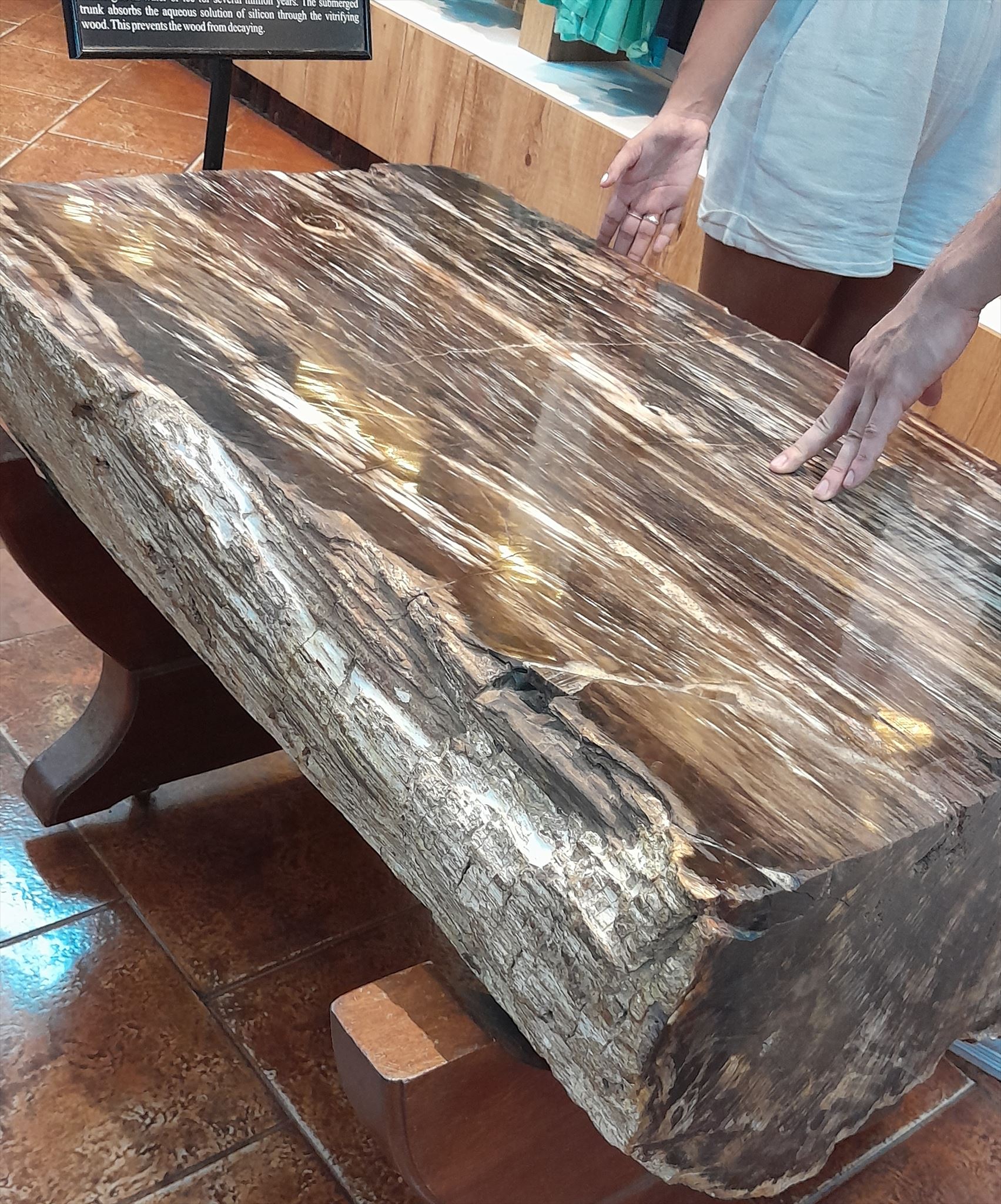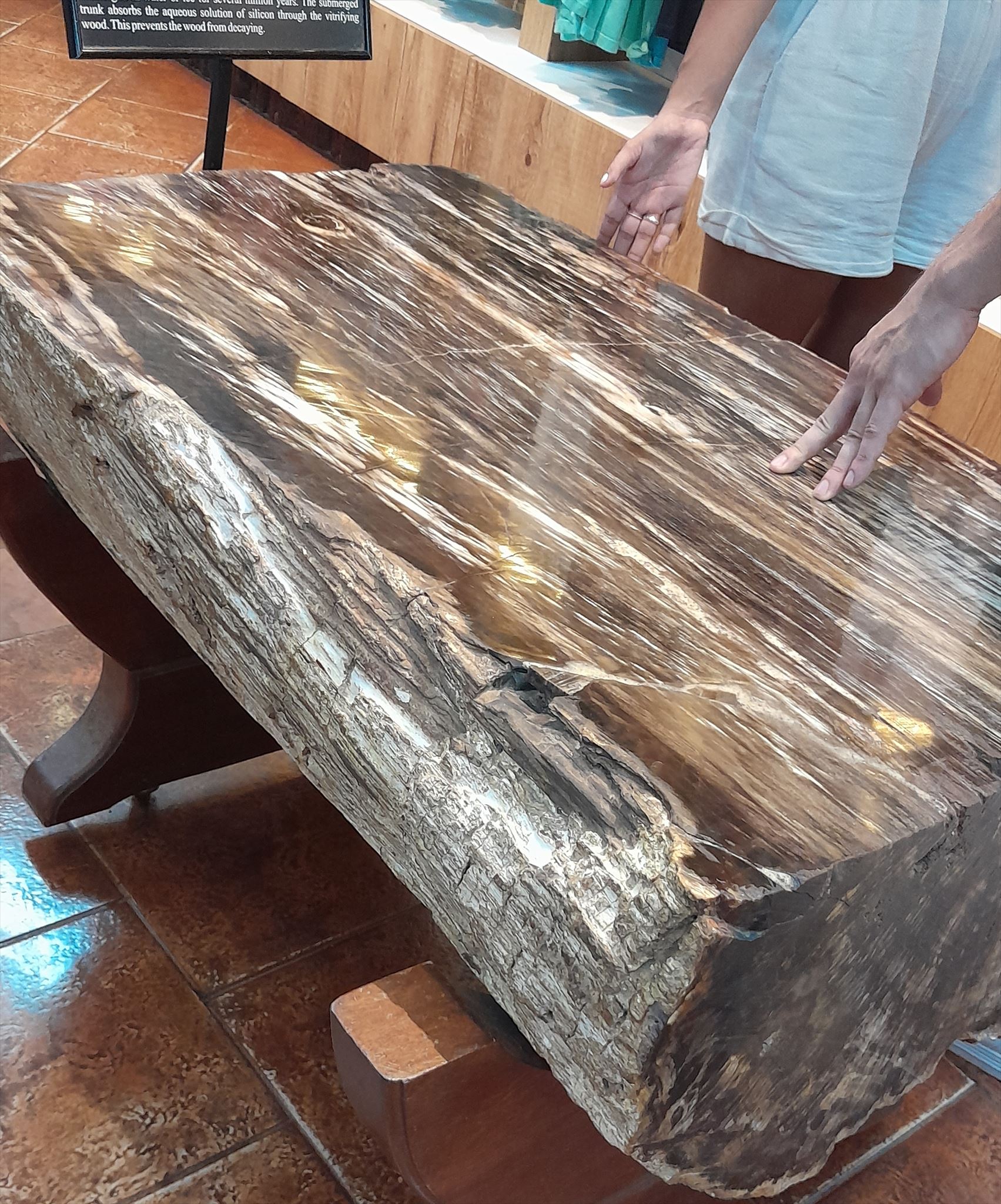A testemunha do Triássico - Madeira petrificada
Esta testemunha do Triássico pode ser encontrada na área de saída do Parque das Aves.

Área da descoberta: Na parte mais ao sul do Brasil, no oeste do estado do Rio Grande do Sul, na região entre as cidades de Santa Maria e São Pedro do Sul, há vários sítios de madeira siliciosa encontrados em uma distância de quase 100 km.
Esse tronco de árvore fossilizado foi formado no período Triássico do Mesozoico e tem entre 180 e 225 milhões de anos. Trata-se de uma conífera primitiva (Araucarioxylon).
As cores do pebblewood são geralmente marrom-claro, bege-claro ou cinza-claro. A preservação das células é geralmente boa. Fragmentos de tronco de madeira siliciosa de até 20 m de comprimento e com diâmetros entre 30 cm e 2 m estão embutidos no arenito Mata marrom-bege claro, que pertence à Formação Caturrita do Triássico Superior. Fragmentos de tronco erodidos com as dimensões mencionadas acima podem ser encontrados na superfície em muitos locais da área.
Origem:
Impedindo a ação dos microrganismos
Quando uma árvore morre, sua madeira é normalmente decomposta ao longo do tempo por bactérias e fungos - ela apodrece. Mas os microrganismos precisam de oxigênio para fazer seu trabalho. Se esse oxigênio estiver faltando, a madeira pode se tornar um fóssil sob as condições certas.
Embalado em cinzas e areia, a fossilização começa
Para "virar pedra", o ar não deve chegar ao pedaço de madeira. Esse é o caso depois de uma erupção vulcânica, por exemplo, quando as cinzas vulcânicas ejetadas enterram os troncos das árvores hermeticamente sob elas. As árvores mortas também podem ser levadas pela correnteza de um rio e, por fim, serem cobertas hermeticamente por lama, areia e outros sedimentos. As árvores ficam enroladas dessa forma por muito, muito tempo. A água se infiltra no solo e transporta substâncias dissolvidas nele, por exemplo, vários minerais. Ela também flui pelo tronco da árvore embutido, e a madeira "coleta" os minerais da água em suas células.
Gradualmente, a madeira orgânica é substituída por minerais inorgânicos. Entretanto, a estrutura e o formato do tronco da árvore permanecem perfeitamente intactos! O mineral mais importante nesse processo é o dióxido de silício (calcedônia mineral). Ele preenche os poros da madeira e a "silicifica". Mas outros minerais também estão envolvidos e são responsáveis pelas belas cores do tronco de árvore petrificado. Os óxidos de ferro, por exemplo, colorem a madeira de vermelho, amarelo ou marrom, enquanto o cobalto e o cromo dão a ela uma cor azul ou verde.
Quanto mais lento for esse processo, melhor será a preservação da estrutura da madeira com os anéis anuais.
Para registrar esse Earthcache como encontrado, é necessário enviar as respostas às seguintes perguntas. Em seguida, poderá fazer o registro imediatamente.
Todas as perguntas devem ser respondidas por meio da leitura da listagem e da observação no local.
Tarefa 1 A estrutura externa da árvore foi preservada?
Tarefa 2 Que taxa de transformação (rápida/lenta) de madeira para pedra isso indica?
Tarefa 3 A cor do tronco da árvore não se deve à cor original da madeira. Em vez disso, é uma consequência da composição química da solução que estava envolvida no processo de fossilização. Em quais variedades de cores os pedaços de tronco aparecem?
Tarefa 4 Qual mineral você acha que é responsável pela coloração?
Tarefa 5: uma foto do maravilhoso Parque das Aves.
A equipe do walli14 deseja a você muita diversão
The witness from the Triassic - petrivied wood
This witness from the Triassic can be found in the exit area of the bird park.

Area of discovery: In the southernmost part of Brazil, in the west of the state of Rio Grande do Sul, in the region between the cities of Santa Maria and São Pedro do Sul, there are numerous sites of siliceous wood found over a distance of almost 100 km.
This fossilized tree trunk was formed in the Triassic period of the Mesozoic and is 180-225 million years old. It is a primeval conifer (Araucarioxylon).
The colors of pebblewood are usually light brown, light beige or light gray. Cell preservation is mostly good. Siliceous wood trunk fragments up to 20 m long and with diameters between 30 cm and 2 m are embedded in the light beige-brown Mata sandstone, which belongs to the Upper Triassic Caturrita Formation. Eroded trunk fragments of the dimensions mentioned above can be found on the surface in many places in the area.
Origin:
Preventing the microorganisms from working
When a tree dies, its wood is normally decomposed over time by bacteria and fungi - it rots. But the microorganisms need oxygen to do their work. If this is missing, the wood can become a fossil under the right conditions.
Packed in ash and sand, fossilization begins
In order to "turn to stone", no air must reach the piece of wood. This is the case after a volcanic eruption, for example, when the ejected volcanic ash buries tree trunks airtight beneath it. Dead trees can also be washed away in a river and eventually be covered airtight by mud, sand and other sediment. The trees lie packed in this way for a long, long time. Water seeps through the soil and transports dissolved substances in it, for example various minerals. It also flows through the embedded tree trunk, and the wood "collects" the minerals from the water in its cells.
Gradually, the organic wood is replaced by inorganic minerals. However, the structure and shape of the tree trunk remain perfectly intact! The most important mineral in this process is silicon dioxide (mineral chalcedony). It fills the pores of the wood and "silicifies" it. But other minerals are also involved and are responsible for the beautiful colors of the petrified tree trunk. Iron oxides, for example, color the wood red, yellow or brown, while cobalt and chromium give it a blue or green color.
The slower this process takes place, the better the structure of the wood with the annual rings is preserved.
To log this Earthcache as found, you have to send us the answers to the following questions. You can then log immediately.
All questions are to be answered by reading the listing and observing on site.
Task 1 Has the outer structure of the tree been preserved?
Task 2 What rate of transformation (fast / slow) from wood to stone does this indicate?
Task 3 The coloration of the tree trunk is not due to the original color of the wood. Rather, it is a consequence of the chemical composition of the solution that was involved in the fossilization process. What are the color variations of the trunk pieces?
Task 4 Which mineral do you think is responsible for the coloration?
Task 5 a photo of the wonderful bird park.
The walli14 team wishes you lots of fun
Der Zeuge aus dem Trias – Versteinertes Holz
Diesen Zeugen aus dem Trias findert im Ausgangsbereich des Volgelparks.

Fundgebiet: Im südlichsten Teil Brasiliens, im Westen des Bundesstaates Rio Grande do Sul, in der Region zwischen den Städten Santa Maria und São Pedro do Sul befinden sich auf einer Strecke von nahezu 100 km zahlreiche Fundstellen von Kieselhölzern.
Dieser versteinerte Baumstamm entstand in der Trias-Periode des Mesozoikums und ist 180-225 Millionen Jahre alt. Es handelt sich um eine urzeitliche Konifere (Araucarioxylon).
Die Farben der Kieselhölzer sind meist ein helles Braun, helles Beige oder helles Grau. Die Zellerhaltung ist überwiegend gut. Kieselholz-Stammfragmente bis zu 20 m Länge und Durchmessern zwischen 30 cm und 2 m sind im hellbeigebraunen Mata-Sandstein eingebettet, der zur obertriassischen Caturrita Formation gehört. Erodierte Stammfragmente o.g. Dimensionen finden sich vielerorts im Gelände an der Oberfläche.
Entstehung:
Die Mikroorganismen am Arbeiten hindern
Wenn ein Baum stirbt, dann wird sein Holz normalerweise mit der Zeit von Bakterien und Pilzen zersetzt – es verrottet. Doch die Mikroorganismen brauchen Sauerstoff für ihre Arbeit. Fehlt dieser, kann das Holz bei den richtigen Bedingungen zu einem Fossil werden.
Eingepackt in Asche und Sand beginnt die Fossilisation
Um „zu Stein“ zu werden, darf also keine Luft zum Holzstück gelangen. Dies ist zum Beispiel der Fall nach einem Vulkanausbruch, wenn die ausgeschleuderte Vulkanasche Baumstämme luftdicht unter sich begräbt. Auch können abgestorbene Bäume in einem Fluss davongeschwemmt und irgendwann von Schlamm, Sand und anderem Sediment luftdicht bedeckt werden. So eingepackt liegen die Bäume für lange, lange Zeit. Wasser sickert durch den Boden und transportiert in ihm gelöste Stoffe, zum Beispiel verschiedene Mineralien. Es durchfliesst auch den eingebetteten Baumstamm, und das Holz „sammelt“ die Mineralien aus dem Wasser in seinen Zellen.
Nach und nach wird so das organische Holz durch anorganische Mineralien ersetzt. Die Struktur und die Form des Baumstammes bleiben dabei aber perfekt erhalten! Das wichtigste Mineral bei diesem Vorgang ist Siliziumdioxid (Mineral Chalcedon) . Es füllt die Poren des Holzes auf und „verkieselt“ dieses. Doch auch andere Mineralien sind beteiligt und verantwortlich für die schönen Farben des versteinerten Baumstamms. Eisenoxide zum Beispiel färben das Holz rot, gelb oder braun, Kobalt und Chrom geben ihm eine blaue oder grüne Farbe.
Je langsamer dieser Prozess vonstattengeht, desto besser bleibt die Struktur des Holzes mit den Jahresringen erhalten.
Um diesen Earthcache als gefunden zu loggen, musst Du an uns die Antworten auf folgende Fragen senden. Danach kannst Du sofort loggen.
Alle Fragen sind durch das Lesen des Listings und Beobachtung vor Ort zu beantworten.
Aufgabe 1 Ist die äußere Struktur des Baumes erhalten geblieben?
Aufgabe 2 Auf was für eine Umwandlungsgeschwindigkeit (schnell / langsam) vom Holz zum Stein lässt das schließen?
Aufgabe 3 Die Färbung des Baumstamm beruht nicht auf der ursprünglichen Farbe des Holzes. Vielmehr ist sie eine Folge der chemischen Zusammensetzung der Lösung, die bei der Versteinerung mitgewirkt haben. In welchen Farbvarietäten zeigen sich die Stammstücke?
Aufgabe 4 Was denkst Du, welches Mineral ist verantwortlich für die Färbung?
Aufgabe 5 ein Foto vom wunderbaren Vogelpark.
Viel Spaß wünscht das Team walli14
Quellen: simplyscience.ch/teens/wissen/versteinerte-waelder-wie-entstehen-die-baeume-aus-stein, petrified-wood.de/fundregionen/br_riograndedosul.htm , eigene Fotos